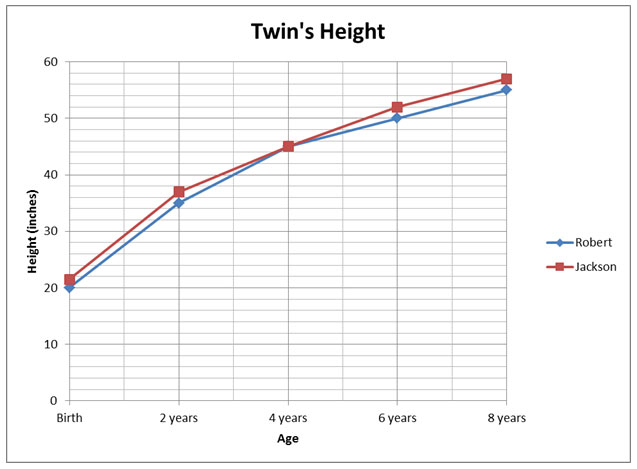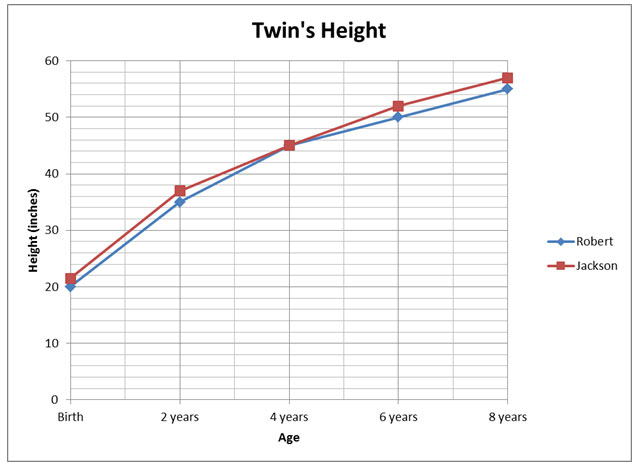
Use the graph to answer the question below.

Which of the following is the best estimate of Robert's height at age 5?
A. 50 inches
Incorrect. That was Robert’s height at age 6.
B. 48.2 inches
Incorrect. That was Jackson’s height at age 5.
C. 52 inches
Incorrect. That was Jackson’s height at age 6.
D. 47.8 inches
Correct!
What trends are displayed in the graph below?

A. The twins are relatively close in weight each year, but Jackson is slightly heavier than Robert, except when they were the same weight at four years old.
Incorrect. What is the dependent variable that is being displayed in this graph?
B. The twins are the same height and weight.
Incorrect. Look carefully at the graph.
C. The twins are relatively close in height each year, but Jackson is slightly taller than Robert, except when they were same height at four years old.
Correct! This best describes the relationship shown in the graph.
D. The twins are relatively close in height each year, but Robert is slightly taller than Jackson, except when they were the same height at four years old.
Incorrect. Look at the graph carefully. Which color of line represents Jackson and Robert.
Industrial wastes can play a large role in polluting rivers, lakes, and streams. A student takes water samples from a river that passes a factory and tests for pollutants. What is the trend shown in the following data table?
|
Distance from Factory (meters)
|
Amount of Pollutants (ppm)
|
|
0
|
1340
|
|
50
|
950
|
|
100
|
630
|
|
150
|
440
|
|
200
|
310
|
|
250
|
200
|
A. The amount of pollutant increases as you get farther from the factory.
Incorrect. The amount of pollutant is decreasing, not increasing.
B. The amount of pollutant decreases as you get farther from the factory.
Correct! The amount of pollutant is decreasing.
C. The amount of pollutant decreases as the number of factories increases.
Incorrect. We do not have any information about the number of factories.
D. The amount of pollutant increases as the number of fish increases.
Incorrect. We do not have any information about the number of fish.
A group of students examined a sample of local pond water. They identified three species of protozoans. They decided to examine the water sample every day for a week. They added food for the protozoans each day and counted the number of each species. Their findings are recorded below.
|
Protozoan Count
|
|||
|
Day
|
Species A
|
Species B
|
Species C
|
|
1
|
25
|
20
|
23
|
|
2
|
50
|
44
|
31
|
|
3
|
85
|
63
|
42
|
|
4
|
102
|
68
|
44
|
|
5
|
140
|
71
|
50
|
|
6
|
180
|
70
|
53
|
|
7
|
192
|
64
|
40
|
Based on the data, which of the inferences is correct?
A. Species B is the food source for Species C.
Incorrect. Nothing in the data indicates that Species B is eating Species C.
B. The food added the best food source for Species B.
Incorrect. The word BEST makes an answer unlikely.
C. Species C had a shorter life span than Species A.
Incorrect. The life span of the species is not analyzed in this data. The number of each species was counted.
D. Species A was successful in acquiring the food needed to survive.
Correct! Species A population continued to grow, which means they are eating and reproducing.